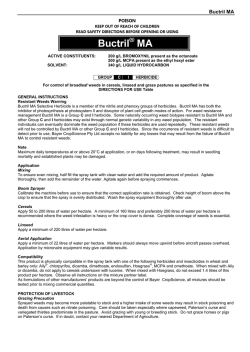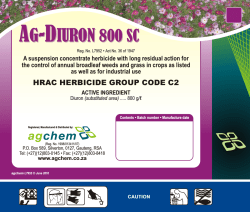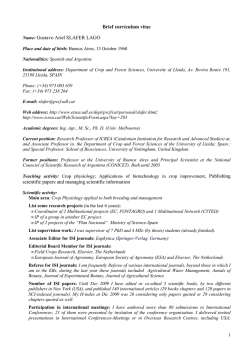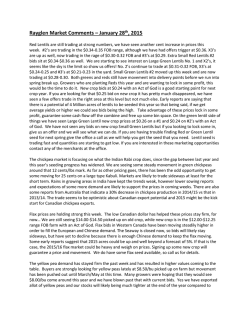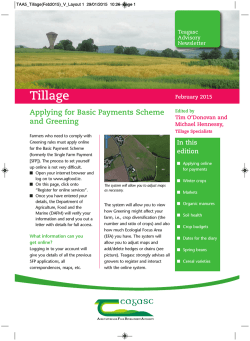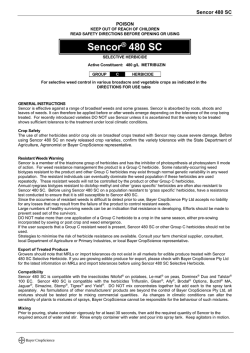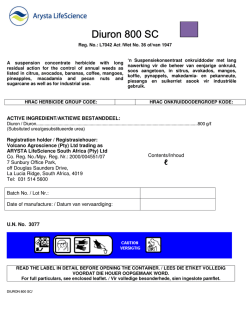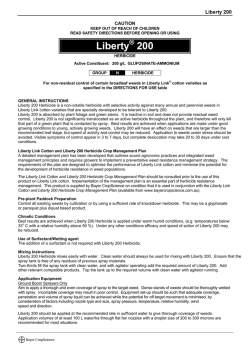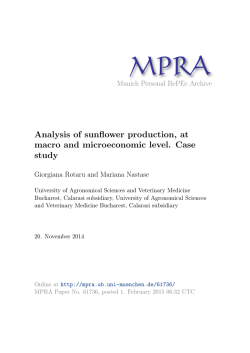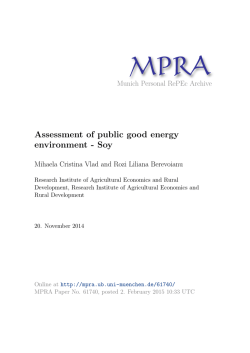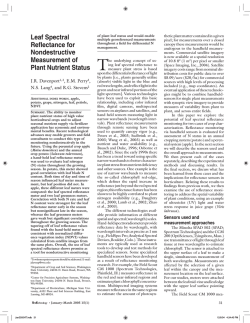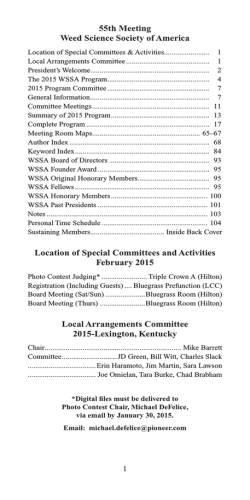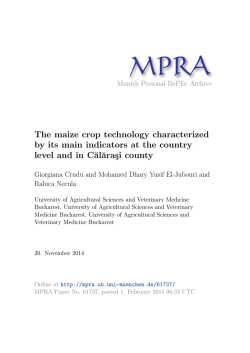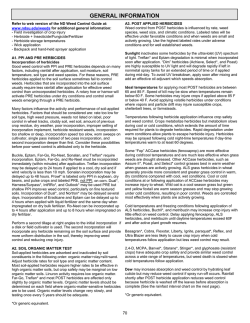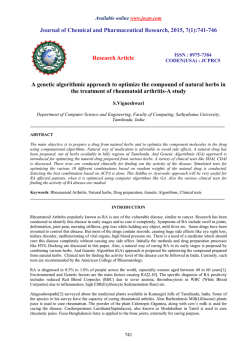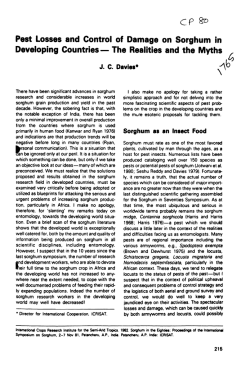
Brodal Options - Bayer CropScience
Brodal Options READ SAFETY DIRECTIONS BEFORE OPENING OR USING Brodal® Options SELECTIVE HERBICIDE Active Constituent: 500 g/L DIFLUFENICAN GROUP F HERBICIDE For control of certain weeds in clover-based pasture, field peas, lentils, lupins and oilseed poppy as specified in the DIRECTIONS FOR USE table GENERAL INSTRUCTIONS For use as an early post-emergence spray in clover-based pasture, field peas, lentils, and lupins. Brodal Options may also be used as a post sowing pre-emergence spray on lupins in New South Wales, Victoria, South Australia and Tasmania. This product provides both contact and residual activity. Residual activity can be expected for up to 8 weeks after application under favourable growing conditions. The level of effective residual control may be reduced where; rates lower than 200 mL/ha are used, dry conditions prevail, poor coverage of the soil surface is achieved, crop is planted in non-wetting sand or where soils have a high content of clay or organic matter. Brodal Options will not effectively control; regrowth of suppressed weeds, transplanted weeds, regrowth from rhizomes or roots, or weeds growing under stress from previous herbicide applications. Weed control may be reduced in areas where trash or burnt straw from previous harvest is dense, such as in header trails. Best results will be obtained if good soil moisture exists at and after application. This product is taken up by the shoots of germinating seeds and seedlings. Susceptible weeds germinate but show immediate chlorosis followed by a mauve-pink discoloration. The chlorosis spreads with the aerial growth and the plants become necrotic and die back. After application, some transient crop discolouration may occur. In lentils and lupins, this usually appears as yellow or white banding on the leaves, while in clover and field peas, white/pink coloration of the leaf veins and tips may occur. Some crop height reduction may also occur. Provided the crop is not under stress from pre-emergent herbicide, disease, insect damage, nutrient deficiency, frost, extremes of pH, dry or excessively moist conditions, the development of the crop and all subsequent growth will not be affected. Some pre-emergence herbicides, such as atrazine, can cause stress to certain crops resulting in an increase in crop damage when using this product. Field peas are particularly sensitive. Clover Tolerance Table VARIETY Arrowleaf (Zulu) Balansa (Paradana) Persian (Kyambro) Strawberry (Palestine) Subterranean (Clare) Subterranean (Junee) Subterranean (Karridale) EFFECT ON VEGETATIVE VARIETY GROWTH Moderate Subterranean (Larissa) Moderate Subterranean (Mt. Barker) Minimal Subterranean (Seaton Park) Moderate Subterranean (Trikkala) Moderate Subterranean (Woogenellup) Moderate White (Haifa) Moderate Reduction in growth - Minimal (0-20%), Moderate (20-50%) EFFECT ON VEGETATIVE GROWTH Moderate Moderate Minimal Minimal Moderate Moderate The following varieties of subterranean clover have been tested for effects on seed yield: Seaton Park, Trikkala and Woogenellup. Some reduction in seed yield may occur with cv. Trikkala. Subsequent Crop Tolerance To reduce the effect on subsequent susceptible crops (e.g. canola) ensure thorough cultivation of soil prior to the sowing of these crops. Resistant Weeds Warning Brodal Options is a member of the nicotinanilide group of herbicides and acts by inhibiting carotenoid biosynthesis. For weed resistance management Brodal Options is a Group F herbicide. Some naturally occurring weed biotypes resistant to Brodal Options and other Group F herbicides may exist through normal genetic variability in any weed population. The resistant individuals can eventually dominate the weed population if these herbicides are used repeatedly. These resistant weeds will not be controlled by Brodal Options or other Group F herbicides. Since the occurrence of resistant weeds is difficult to detect prior to use, Bayer CropScience Pty Ltd accepts no liability for any losses that may result from the failure of Brodal Options to control resistant weeds. Brodal Options Mixing Stir product or invert container several times before use as settling may occur after storage for some weeks. To ensure even mixing, half fill the spray tank with clean water and add the required amount of product. Agitate thoroughly then add the remainder of the water. Agitate thoroughly while carrying out spray operations. Reseal part-used container immediately after use. Application Ground A minimum water rate of 50 L/ha should be used, however, for optimum results water rates of 70 - 100 L/ha are recommended. Increase the water volume where weed infestation is heavy or the crop cover is dense. Complete coverage of weeds is essential. Higher water volumes (up to 100 L/ha) will ensure improved activity of the product on the weeds but may increase the symptoms of crop damage. The following settings are examples that will ensure excellent coverage of exposed weeds: WATER RATE NOZZLE SPEED PRESSURE 50 L/ha Hardi No. 10 or equivalent 10 kph 240 kPa (2.4 bar) 75 L/ha Hardi No. 12 or equivalent 10 kph 220 kPa (2.2 bar) 75 L/ha Hardi No. 14 or equivalent 12 kph 210 kPa (2.1 bar) Compatibility Brodal Options is physically compatible with most currently registered grass herbicides as two-way tank mixtures. BRODAL OPTIONS RATE Up to 150 mL All rates Up to 100 mL COMPATIBLE PRODUCT Simazine (500 g/L product) up to 1.0 L/ha. Decis Options®, dimethoate formulations, Dominex® 100EC, Hallmark® 50EC, Karate®, Le-Mat® 290 SL, Lexone®, Sencor®, Talstar® and Targa®. Eclipse® up to 7 g/ha (provided water hardness does not exceed 500 ppm) Warning For tank-mixtures with grass herbicides, use the recommended rates for both herbicides as well as the surfactant recommendations of the grass herbicide. Read the label for the grass herbicide before mixing and using the tank mixtures. DO NOT use crop oils with Brodal Options or Brodal Options/grass herbicide tank-mixtures. Applications to lupins and field peas under stressed conditions may cause significant damage to the crop. When tank mixing Brodal Options and Targa, use a surfactant only. Mixtures of Brodal Options and Verdict® applied to lupins or field peas can cause damage that may result in yield losses. Consult your local Bayer CropScience representative or the relevant grass herbicide manufacturer for advice on application and timing of tank-mixtures. Tank mixes with simazine, metribuzin or Eclipse should be applied post-emergence to lupins crops only, and only to lupin varieties and at lupin growth stages recommended for these products. Increased crop effects may be experienced with the tank mix. Do not apply Brodal Options in mixture with simazine or metribuzin to Myallie lupins if atrazine has been applied pre-emergence. DO NOT apply tank-mixtures to clover. As formulations of other manufacturers' products are beyond the control of Bayer CropScience, all mixtures should be tested prior to mixing commercial quantities. PROTECTION OF CROPS, NATIVE AND OTHER NON-TARGET PLANTS DO NOT apply under weather conditions, or from spraying equipment, that may cause spray to drift onto nearby susceptible plants/crops, cropping lands or pastures. PROTECTION OF WILDLIFE, FISH, CRUSTACEANS AND ENVIRONMENT DO NOT contaminate streams, rivers or waterways with the chemical or used containers. STORAGE AND DISPOSAL Keep out of reach of children. Store in the closed, original container in a dry, cool, well-ventilated area, out of direct sunlight. Triple or preferably pressure rinse containers before disposal. Add rinsings to spray tank. Do not dispose of undiluted chemicals on site. If recycling, replace cap and return clean containers to recycler or designated collection point. If not recycling, break, crush, or puncture and bury empty containers in a local authority landfill. If no landfill is available, bury the containers below 500 mm in a disposal pit specifically marked and set up for this purpose clear of waterways, desirable vegetation and tree roots. Empty containers and product should not be burnt. SAFETY DIRECTIONS Avoid contact with eyes and skin. Wash hands after use. FIRST AID If poisoning occurs, contact a doctor or Poisons Information Centre (telephone 13 11 26). MATERIAL SAFETY DATA SHEET Additional information is listed in the Material Safety Data Sheet, which can be obtained from www.bayercropscience.com.au Brodal Options EXCLUSION OF LIABILITY This product must be used strictly as directed, and in accordance with all instructions appearing on the label and in other reference material. So far as it is lawfully able to do so, Bayer CropScience Pty Ltd accepts no liability or responsibility for loss or damage arising from failure to follow such directions and instructions. APVMA Approval No.: 53843/0905 Asulox®, Brodal®, Decis Options®, Le-Mat®, Sencor® and Tramat® are Registered Trademarks of Bayer. FOR 24 HOUR SPECIALIST ADVICE IN EMERGENCY ONLY PHONE 1800 033 111 DIRECTIONS FOR USE Restraints DO NOT apply if crop or weeds are stressed due to dry or excessively moist conditions. DO NOT apply to crops or weeds under stress due to pre-emergence herbicide, root disease, insect damage, nutrient deficiency, excessively moist or dry conditions or extremes of pH. DO NOT apply to frost affected crops or if frosts are imminent. DO NOT apply if heavy rain is expected within 4 hours. CROP Cloverbased pasture, field peas, lentils, lupins WEEDS STATE WEED STAGE CONTROLLED Wild radish WA only Up to 2 leaf (Raphanus stage and not raphanistrum) more than 60 mm in diameter Up to 4 leaf stage and not more than 120 mm in diameter Up to 6 leaf stage and not more than 180 mm in diameter Up to 4 leaf NSW, stage and not Vic, Tas, SA more than 120 mm in diameter only Hedge mustard WA only Up to 2 leaf (Sisymbrium stage and not officinale), more than 60 Indian hedge mm in diameter mustard NSW, Up to 4 leaf (Sisymbrium Vic, stage and not orientale), Tas, more than 120 wild turnip SA, WA mm in diameter (Brassica only Up to 6 leaf tournefortii) stage and not Turnip weed (Rapistrum rugosum) Charlock (wild mustard, Sinapis arvensis), deadnettle (Lamium amplexicaule) Prickly lettuce (Lactuca serriola) Pheasants eye (Adonis microcarpa) NSW, Vic, Tas, SA, WA only NSW, Vic, Tas, SA only SA only more than 180 mm in diameter Up to 4 leaf stage and not more than 120 mm in diameter Up to 2 leaf stage and not more than 60 mm in diameter RATE 100 mL/ha 150 mL/ha 200 mL/ha CRITICAL COMMENTS Sow crop evenly to a depth of at least 20 mm. CROP STAGE CLOVER-BASED PASTURE: Apply post-emergence, not before the 3rd trifoliate leaf stage. Warning: Some species and varieties of clover may be more sensitive than others. Refer to legume tolerance table in the general instructions. DO NOT apply to medics or yellow serradella. FIELD PEAS: Apply early post-emergence after the third node stage and before the start of flowering. Warning: Field peas grown on high pH soils in the presence of free lime may be less tolerant to Brodal Options. 100 mL/ha 150 mL/ha 200 mL/ha LENTILS: Apply early post-emergence after the third leaf stage of the crop and before the start of flowering. Warning: Some lentil varieties may be more sensitive than others. DO NOT apply to Northfield variety. Avoid spray overlap. Refer to GENERAL INSTRUCTIONS. LUPINS: Post-emergence of Crop: Apply postemergence from the 2 leaf stage of the crop and before the start of primary flowering (big bud). Post-sowing, Pre-emergence of Crop (Not WA): Apply in a tank mix with the recommended rate of post-sowing preemergence treatment of simazine. (Brodal Options should not be incorporated). APPLICATION AND WEED CONTROL Apply when weeds are actively growing. Good spray coverage of the weeds is important. Apply before weeds are obscured by the crop canopy. For optimum results apply 4 to 6 weeks postsowing. Application beyond 8 weeks post-sowing may result in reduced levels of weed control. In most situations the rate specified for each weed size will give satisfactory control. Under certain conditions such as: * high crop and weed density, * late season germinations, * abnormal weed growth (including early flowering); higher rates of product (up to the maximum rate of application specified for that weed) may be required. Brodal Options CROP WEEDS CONTROLLED STATE WEED STAGE RATE CRITICAL COMMENTS Suppression of the Following Weeds Cloverbased pasture, field peas, lentils, lupins CROP Field peas Capeweed (Arctotheca calendula), crassula (Crassula spp.), corn gromwell (Buglossoides arvense), marshmallow (Malva parviflora), shepherd’s purse (Capsella bursapastoris) Chickweed (Stellaria media), hyssop loosestrife (Lythrum hyssopifolia), mouse-eared chickweed (Cerastium glomeratum), night-scented stock (Matthiola longipetala), skeleton weed (Chondrilla juncea), speedwell (Veronica hederifolia) Amsinckia (Amsinckia spp.), wireweed (Polygonum aviculare) Paterson's curse (salvation Jane) (Echium plantagineum), rough poppy (Papaver hybridum) sorrel (Rumex acetosella), toad rush (Juncus bufonius) Stinging nettle (Urtica urens) WEEDS CONTROLLED Prickly lettuce (Lactuca serriola) NSW, Vic Tas, SA, WA only Up to 4 leaf stage and not more than 120 mm in diameter (Refer Critical Comments previous page) NSW, Vic, Tas, SA only NSW, Vic, Tas, SA only Up to 2 leaf stage and not more than 60 mm in diameter NSW, Vic, SA only NSW, Vic, Tas, SA only NSW only Cotyledon stage STATE NSW, Vic, Tas, SA only WEED STAGE 4 leaf 6 leaf Charlock (wild mustard, Sinapis arvensis) 200 mL/ha 4 leaf 6 - 8 leaf RATE 125 mL/ha plus 125 mL/ha MCPA amine (500 g/L) 150 mL/ha plus 150 mL/ha MCPA amine (500 g/L) 125 mL/ha plus 125 mL/ha MCPA amine (500 g/L) 150 mL/ha plus 150 mL/ha MCPA amine (500 g/L) CRITICAL COMMENTS (Refer Critical Comments previous page) Brodal Options CROP Lupins Danja, Gungurru, Kalya, Kiev and Tanjil varieties For information on other varieties contact Bayer CropScience WEEDS CONTROLLED Wild radish (Raphanus raphanistrum) STATE WEED STAGE RATE WA only Up to 8 leaf stage and not more than 200 mm in diameter 100 mL/ha plus 7 g/ha Eclipse® Capeweed (Arctotheca calendula), (suppression only) CRITICAL COMMENTS CROP STAGE Apply no earlier than the 8 leaf stage and before the start of primary flowering (big bud). APPLICATION AND WEED CONTROL Apply when weeds are actively growing. Good spray coverage of the weeds is important. Apply before weeds are obscured by the crop canopy. Control may be reduced where wild radish populations exceed 100 plants per m2. Up to 6 leaf stage Do not add crop oils, wetters, surfactants, insecticides or grass herbicides as unacceptable crop damage may occur. A minimum of ten days should elapse between application of a grass herbicide and this mixture. Do not use where water hardness exceeds 500 ppm. Lupins should be actively growing at the time of treatment with no evidence of brown leaf spot or insect damage. A slight yellowing, often accompanied by height reduction, may be noticeable from 1-4 weeks after application, however these effects are generally transient. Avoid spraying double overlaps. Oilseed poppy Charlock (Sinapis arvensis), hedge mustard (Sisymbrium officinale), Indian hedge mustard (Sisymbrium orientale), wild radish (Raphanus raphanistrum), wild turnip (Brassica tournefortii) Tas only Early postemergence up to the 4 leaf stage and not more than 120 mm in diameter 150 mL/ha (4 -6 leaf crop stage) and/or 200 mL/ha (6 -10 leaf crop stage) CROP STAGE Brodal Options may be mixed with Reglone® or Asulox® based on recommendations from poppy contracting companies. DO NOT use in mixtures with Tramat®. APPLICATION AND WEED CONTROL See comments on clover-based pasture, field peas, lentils and lupins. NOT TO BE USED FOR ANY PURPOSE, OR IN ANY MANNER, CONTRARY TO THIS LABEL UNLESS AUTHORISED UNDER APPROPRIATE LEGISLATION. WITHHOLDING PERIODS Harvest: NOT REQUIRED WHEN USED AS DIRECTED Grazing: All Crops - DO NOT GRAZE OR CUT FOR STOCKFEED FOR 14 DAYS AFTER APPLICATION
© Copyright 2025
